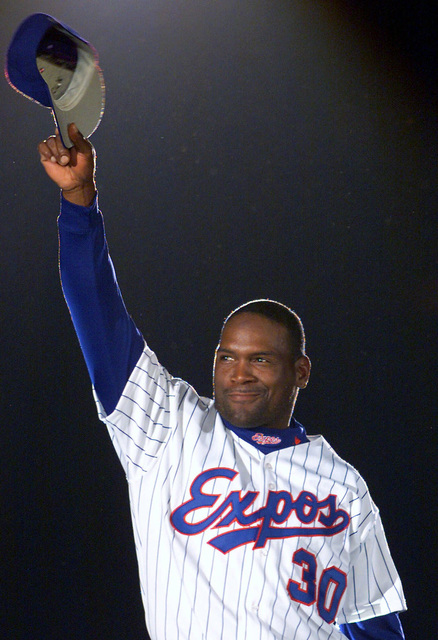Barry Bonds, Roger Clemens have legitimate chance to make Hall of Fame
Never in our lifetime might not prove to be such an indefinite journey after all.
So now the floodgates are open, is right.
The newest Baseball Hall of Fame class was announced Wednesday, and while those who earned induction by receiving at least 75 percent of the vote garnered the most recognition — Jeff Bagwell, Tim Raines and Ivan Rodriguez — it’s where a few other names finished in balloting that sends a most significant message.
Barry Bonds and Roger Clemens, once thought not capable of departing the dugout when it came to how voters would ultimately decide their Hall of Fame fate, are now rounding second and have a legitimate opportunity to eventually touch home plate in Cooperstown.
Translation: A definite shift of judgment is underway among the electorate, and it’s no longer assumed the only path two of the biggest stars from the steroids era have of making the Hall of Fame would be the immense challenge of being approved by the veterans committee.
They might actually get in the old-fashioned way. Given some recent inclusions, it’s getting tougher and tougher to deny them entry.
Which doesn’t mean they and others on the Hall of Fame bubble didn’t cheat like hell.
It just means the tide of perspective has shifted.
Another year of voting has passed, and each continues to see his support rise, proven again Wednesday when Bonds landed on 53.8 percent of ballots and Clemens on 54.1. History tells us that rare is the player who reaches 50 percent and doesn’t ultimately become enshrined. Bonds and Clemens are in the fifth year of a decade-long period of consideration, and the more new faces are welcomed to the voting process, the more likely each could make it.
There is also a boatload of irony that goes with such ascension, given the person Bonds and Clemens can probably thank most for their spike in acceptance is the man who stood front and center during the time players embraced the use of performance-enhancing drugs and a power surge defined the game beginning in the late 1980s.
Bud Selig was always complicit in this mess as commissioner, but he made the Hall of Fame last month via a 16-person Today’s Game Era committee, which focuses on players and contributors from 1988 on.
“I think it sends a signal that you can’t very well honor the enablers and yet also continue to penalize the guys who were either encouraged or allowed (to use),” said Tim Sullivan, sports columnist for the Louisville Courier-Journal and Hall of Fame voter for almost 15 years before giving up his vote after watching former slugger Mark McGwire remain mum on steroids when testifying before Congress in 2005. “Selig’s induction is a big step for players (such as Bonds and Clemens). He was at the helm when all of this was going on, when he either had his head in the sand or was willfully ignorant.”
Bagwell’s career in Houston was clouded with suspicion about possible PED use, and Rodriguez was linked to steroids when Jose Canseco wrote in his book that he personally educated him and other teammates about drugs and injected them many times while in Texas. The whispers only grew louder when Rodriguez, then with the Detroit Tigers and in the midst of the steroids scandal gaining steam nationally with players feeling the heat of possibly being caught, reported to training camp 30 pounds lighter than the previous season.
But he and Bagwell are in now, along with Selig. So is Mike Piazza, another suspected user having made the Hall last year. Should the time have already come for Baseball Writers’ Association of America members to remove from their consciousness this implied moral dilemma regarding the steroids era they face when casting ballots?
It remains difficult for some who have stood firm in their stance of only voting for those players they believed to have competed in a clean manner, a quandary that can be incredibly difficult to manage internally.
“It’s very hard, and yet it wouldn’t surprise me if (Bonds and Clemens) both eventually get in, but it would disappoint me,” said Pedro Gomez, ESPN baseball reporter and Hall of Fame voter. “I’ve talked to as many players and managers and coaches as I can over the years, obviously off the record, to help determine my viewpoint. In addition to the beauty of baseball, it also passes the eye test better than any sport, and there is no disputing the inflation of numbers during that era.
“When a career .296 hitter hits .362 at age 39, you can’t tell me performance-enhancing drugs didn’t help. And that’s exactly what Bonds did. I saw it. I watched the games. But I also don’t think younger voters coming in now have as great an issue with the (steroids era) as the generation above them.”
That’s the way things are trending. Of 14 first-time voters who made their ballots public, 13 supported Bonds and Clemens. Each player also picked up a significant amount of support from returning voters.
Which means while the floodgates might not be wide open, the initial rush has begun.
In this sense, how can Bonds and Clemens and, well, all other deserving types from the steroids era be kept out?
Contact columnist Ed Graney at egraney@reviewjournal.com or 702-383-4618. He can be a heard on “Seat and Ed” on Fox Sports 1340 from 2 p.m. to 4 p.m. Monday through Friday. Follow @edgraney on Twitter.

























